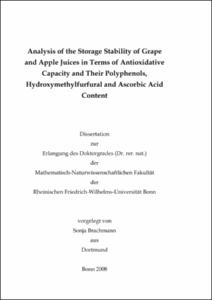Analysis of the Storage Stability of Grape and Apple Juices in Terms of Antioxidative Capacity and Their Polyphenols, Hydroxymethylfurfural and Ascorbic Acid Content

Analysis of the Storage Stability of Grape and Apple Juices in Terms of Antioxidative Capacity and Their Polyphenols, Hydroxymethylfurfural and Ascorbic Acid Content

| dc.contributor.advisor | Galensa, Rudolf C. | |
| dc.contributor.author | Brachmann, Sonja | |
| dc.date.accessioned | 2020-04-12T19:19:37Z | |
| dc.date.available | 2020-04-12T19:19:37Z | |
| dc.date.issued | 2008 | |
| dc.identifier.uri | https://hdl.handle.net/20.500.11811/3706 | |
| dc.description.abstract | The aim of this work is to determine the storage stability of commercial grape and apple juices. Two storage studies are performed to provide extensive knowledge about the changes of the selected juices under different storage conditions. The analysis of fruit juice stability is of certain interest not only for the juice production but also for the development of new materials and composites for food packaging. Deterioration of each juice is observed during one year of storage (i.e. usual period of shelf-life). Sensory quality as well as antioxidative capacity and concentrations of single juice compounds (especially antioxidants like polyphenols or ascorbic acid) are determined to clarify whether the antioxidative status of a juice can provide useful information concerning its storage stability. In addition to the optimisation of the HPLC analysis of several juice compounds a new test is developed to determine the antioxidative capacity of a juice via electrochemical reactions of antioxidants. The voltammographic analysis of the reducing potential (VARP) assay uses the coulometric electrode array detector (CEAD) without prior HPLC separation. The resulting voltammogram shows the ability of the sample to reduce other molecules and thus, provides an indication of the antioxidative capacity of the sample. It is shown that this fast, simple and sensitive method enables the detection of minor changes of the antioxidative status of the stored juice. In conclusion, the storage studies demonstrate which parameters are mainly influenced by storage time, temperature and oxygen permeation of the packaging. They also point out how to ensure adequate storage stability. Furthermore, for fruit juices with considerable amounts of antioxidants strong correlations are revealed between VARP data and sensory evaluations under different storage conditions. These findings indicate that antioxidative capacity might be associated with sensory color and taste evaluation. In contrast, a juice with low amounts of antioxidants is less affected by storage temperature and an oxygen permeable packaging. The results indicate that such a juice might obtain an adequate storage stability when filled in packaging with considerable oxygen permeability. The use of this packaging could reduce the production costs since the aluminium foil accounts for a considerable share. | en |
| dc.description.abstract | Untersuchung der Lagerstabilität von Trauben- und Apfelsäften in Bezug auf ihre antioxidative Kapazität sowie ihren Gehalt an Polyphenolen, Hydroxymethylfurfural und Ascorbinsäure Ziel dieser Arbeit ist es, die Lagerstabilität handelsüblicher Trauben- und Apfelsäfte zu bestimmen. Zwei Lagerungsstudien werden durchgeführt, um umfassende Erkenntnisse über die Veränderungen ausgewählter Säfte unter verschiedenen Lagerungsbedingungen zu gewinnen. Die Stabilitätsuntersuchung von Fruchtsäften ist nicht nur für die Saftherstellung von gewissem Interesse, sondern auch für die Entwicklung von neuen Materialien und Verbundstoffen für die Verpackung von Lebensmitteln. Die Veränderung jedes Saftes wird im Lagerungsverlauf eines Jahres beobachtet (dies entspricht dem üblichen Haltbarkeitszeitraum). Die sensorische Qualität, sowie die antioxidative Kapazität und die Konzentrationen einzelner Saftbestandteile (insbesondere Antioxidantien wie Polyphenole oder Ascorbinsäure) werden bestimmt, um zu klären, ob mit Hilfe des antioxidativen Status eines Saftes eine Aussage über seine Lagerungsstabilität getroffen werden kann. Zusätzlich zur Optimierung der HPLC Analyse einiger Saftbestandteile wird ein neues Verfahren entwickelt, um die antioxidative Kapazität eines Saftes mit Hilfe der elektrochemischen Reaktionen seiner Antioxidantien zu bestimmen. Die voltammographische Analyse des reduzierenden Potentials (VARP) verwendet den coulometrischen Elektrodenarraydetektor (CEAD) ohne eine vorhergehende HPLC-Trennung durchzuführen. Das resultierende Voltammogramm zeigt die Fähigkeit einer Probe, andere Moleküle zu reduzieren und gibt damit einen Hinweis auf die antioxidative Kapazität der Probe. Es wird gezeigt, dass diese schnelle, einfache und sensitive Methode geeignet ist, um bereits kleine Veränderungen des antioxidativen Status des gelagerten Saftes festzustellen. Schließlich zeigen die Lagerungsstudien auf, welche Parameter hauptsächlich von der Lagerungszeit und -temperatur, sowie von der Sauerstoffdurchlässigkeit der Verpackung beeinflusst werden. Zudem stellen sie dar, wie eine angemessene Lagerstabilität gewährleistet werden kann. Darüber hinaus werden für Fruchtsäfte mit einem hohen Gehalt an Antioxidantien starke Korrelationen zwischen VARP-Daten und sensorischer Beurteilung unter verschiedenen Lagerungsbedingungen offenbart. Diese Erkenntnisse deuten darauf hin, dass die antioxidative Kapazität mit der sensorischen Farbund Geschmacksbewertung verknüpft sein könnte. Im Gegensatz dazu wird ein Saft mit geringem Gehalt an Antioxidantien durch Lagerungstemperatur und eine sauerstoffdurchlässige Verpackung weniger beeinflusst. Die Ergebnisse zeigen, dass ein solcher Saft eine ausreichende Lagerstabilität aufweisen könnte, wenn er in einer Verpackung mit erhöhter Sauerstoffdurchlässigkeit abgefüllt wird. Die Benutzung dieser Verpackung könnte die Produktionskosten senken, da die Aluminiumfolie hieran einen beträchtlichen Anteil hat. | en |
| dc.language.iso | eng | |
| dc.rights | In Copyright | |
| dc.rights.uri | http://rightsstatements.org/vocab/InC/1.0/ | |
| dc.subject | Haltbarkeit | |
| dc.subject | Lagerungsveränderung | |
| dc.subject | handelsüblich | |
| dc.subject | Fruchtsaft | |
| dc.subject | laminierte Kartonverpackung | |
| dc.subject | Verbundstoff | |
| dc.subject | Flüssigchromatographie | |
| dc.subject | elektrochemische Detektion | |
| dc.subject | Massenspektrometrie | |
| dc.subject | Gaschromatographie | |
| dc.subject | Voltammographische Analyse des reduzierenden Potentials | |
| dc.subject | Voltammogramm | |
| dc.subject | Antioxidanzien | |
| dc.subject | Anthocyanidine | |
| dc.subject | Anthocyane | |
| dc.subject | Gallussäure | |
| dc.subject | Chlorogensäure | |
| dc.subject | sensorische Bewertung | |
| dc.subject | Farbe | |
| dc.subject | Geschmack | |
| dc.subject | Sauerstoffgehalt | |
| dc.subject | polyphenolisch | |
| dc.subject | shelf-life | |
| dc.subject | alteration | |
| dc.subject | changes | |
| dc.subject | commercial fruit juice | |
| dc.subject | laminated carton package | |
| dc.subject | composite packaging | |
| dc.subject | HPLC | |
| dc.subject | liquid chromatography | |
| dc.subject | CEAD | |
| dc.subject | electrochemical detection | |
| dc.subject | coularray | |
| dc.subject | coul array | |
| dc.subject | mass spectrometry | |
| dc.subject | GC | |
| dc.subject | gas chromatography | |
| dc.subject | VARP | |
| dc.subject | voltammographic analysis of the reducing potential | |
| dc.subject | voltammogram | |
| dc.subject | TOSC | |
| dc.subject | total oxidants scavenging capacity | |
| dc.subject | antioxidants | |
| dc.subject | vitamin c | |
| dc.subject | polyphenol | |
| dc.subject | anthocyanidins | |
| dc.subject | Anthocyanins | |
| dc.subject | gallic acid | |
| dc.subject | chlorogenic acid | |
| dc.subject | phloridzin | |
| dc.subject | HMF | |
| dc.subject | hydroxy methyl furfural | |
| dc.subject | color | |
| dc.subject | taste | |
| dc.subject | sensory eval | |
| dc.subject.ddc | 540 Chemie | |
| dc.title | Analysis of the Storage Stability of Grape and Apple Juices in Terms of Antioxidative Capacity and Their Polyphenols, Hydroxymethylfurfural and Ascorbic Acid Content | |
| dc.type | Dissertation oder Habilitation | |
| dc.publisher.name | Universitäts- und Landesbibliothek Bonn | |
| dc.publisher.location | Bonn | |
| dc.rights.accessRights | openAccess | |
| dc.identifier.urn | https://nbn-resolving.org/urn:nbn:de:hbz:5N-16027 | |
| ulbbn.pubtype | Erstveröffentlichung | |
| ulbbnediss.affiliation.name | Rheinische Friedrich-Wilhelms-Universität Bonn | |
| ulbbnediss.affiliation.location | Bonn | |
| ulbbnediss.thesis.level | Dissertation | |
| ulbbnediss.dissID | 1602 | |
| ulbbnediss.date.accepted | 17.10.2008 | |
| ulbbnediss.fakultaet | Mathematisch-Naturwissenschaftliche Fakultät | |
| dc.contributor.coReferee | König, Gabriele M. |
Dateien zu dieser Ressource
Das Dokument erscheint in:
-
E-Dissertationen (4442)




